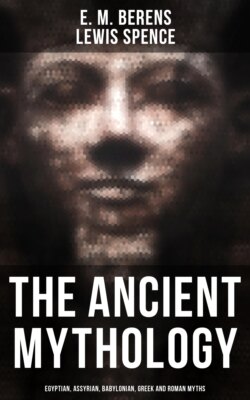Читать книгу The Ancient Mythology: Egyptian, Assyrian, Babylonian, Greek and Roman Myths - Lewis Spence - Страница 76
На сайте Литреса книга снята с продажи.
CHAPTER IV:
THE GILGAMESH EPIC
ОглавлениеTable of Contents
As it is probable that the materials of the Gilgamesh epic, the great mythological poem of Babylonia, originally belong to the older epoch of Babylonian mythology, it is fitting that it should be described and considered before passing to the later developments of Chaldean religion.
The Gilgamesh epic ranks with the Babylonian myth of creation as one of the greatest literary productions of ancient Babylonia. The main element in its composition is a conglomeration of mythic matter, drawn from various sources, with perhaps a substratum of historic fact, the whole being woven into a continuous narrative around the central figure of Gilgamesh, prince of Erech. It is not possible at present to fix the date when the epic was first written. Our knowledge of it is gleaned chiefly from mutilated fragments belonging to the library of Assur-bani-pal, but from internal and other evidence we gather that some at least of the traditions embodied in the epic are of much greater antiquity than his reign. Thus a tablet dated 2100 B.C. contains a variant of the deluge story inserted in the XIth tablet of the Gilgamesh epic. Probably this and other portions of the epic existed in oral tradition before they were committed to writing—that is, in the remote Sumerian period.
Assur-bani-pal was an enthusiastic and practical patron of literature. In his great library at Nineveh (the nucleus of which had been taken from Calah by Sennacherib) he had gathered a vast collection of volumes, clay tablets, and papyri, most of which had been carried as spoil from conquered lands. He also employed scribes to copy older texts, and this is evidently how the existing edition of the Gilgamesh epic came to be written. From the fragments now in the British Museum it would seem that at least four copies of the poem were made in the time of Assur-bani-pal. They were not long permitted to remain undisturbed. The great Assyrian empire was already declining; ere long Nineveh was captured and its library scattered, while plundering hordes burnt the precious rolls of papyrus, and buried the clay tablets in the debris of the palace which had sheltered them.
There they were destined to lie for over 2000 years, till the excavations of Sir A. H. Layard, George Smith, and others brought them to light. It is true that the twelve tablets of the Gilgamesh epic (or rather, the fragments of them which have so far been discovered) are much defaced; frequently the entire sense of a passage is obscured by a gap in the text, and this, when nice mythological elucidations are in question, is no light matter. Yet to such an extent has the science of comparative religion progressed in recent years that we are probably better able to read the true mythological significance of the epic than were the ancient Babylonians themselves, who saw in it merely an account of the wanderings and exploits of a national hero.
The epic, which centres round the ancient city of Erech, relates the adventures of a half-human, half-divine hero, Gilgamesh by name, who is king over Erech. Two other characters figure prominently in the narrative—Eabani, who evidently typifies primitive man, and Ut-Napishtim, the hero of the Babylonian deluge myth. Each of the three would seem to have been originally the hero of a separate group of traditions which in time became incorporated, more or less naturally, with the other two.
The first and most important of the trio, the hero Gilgamesh, may have been at one time a real personage, though nothing is known of him historically.1 Possibly the exploits of some ancient king of Erech have furnished a basis for the narrative. His name (for a time provisionally read Gisdhubar, or Izdubar, but now known to have been pronounced Gilgamesh2) suggests that he was not Babylonian but Elamite or Kassite in origin, and from indications furnished by the poem itself we learn that he conquered Erech (or relieved the city from a besieging force) at the outset of his adventurous career. It has been suggested also that he was identical with the Biblical Nimrod, like him a hero of ancient Babylon; but there are no other grounds for the suggestion.
So much for the historical aspect of Gilgamesh. His mythological character is more easily established. In this regard he is the personification of the sun. He represents, in fact, the fusion of a great national hero with a mythical being. Throughout the epic there are indications that Gilgamesh is partly divine by nature, though nothing specific is said on that head. His identity with the solar god is veiled in the popular narrative, but it is evident that he has some connexion with the god Shamash, to whom he pays his devotions and who acts as his patron and protector.
